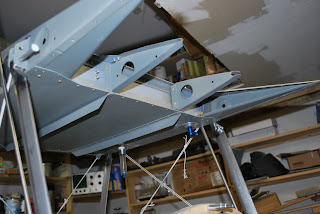




Got a chance to fit the the new design landing gear compression struts yesterday. All-in-all I was very pleased with the first look. We just used a kluged-up mixture of urethane bushings to see how they reacted. The amber bushings are of soft durometer and the blue are somewhat harder. You can see the bulge in the amber bushings yielding about 1/2" of compression. We did not use any pre-load of the bushings but some will be required. We won't be able to choose the proper durometer, number of urethane bushings, and preload until the weight of the complete airplane including pilot and fuel can be applied.
This strut design provides the following features:
1. Tunable "spring rate" and possible progressive spring rate.
2. Adjustable preload of strut.
3. Adjustable ride height.
4. Fail-safe relative to bungee breaking.
5. More compact than bungees.
6. Much simpler to build compared to the bungee strut.
As a matter of interest, the left strut in the photos is set up for maximum spring rate and zero travel as it has no bushings. Might be a little on the "hard" side!




















































